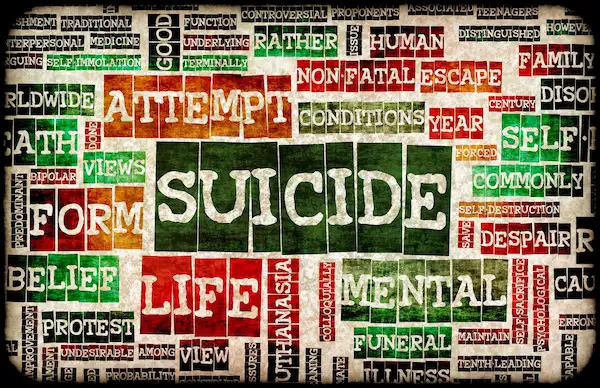Suicide Prevention: Recognising Red Flags and Risk Factors
Learn how to recognise suicide warning signs and risk factors. Discover actionable steps to support someone in crisis and prevent tragedy.


Introduction
Imagine a friend who has been quiet lately suddenly gives away their favorite guitar. A family member battling depression jokes about not being around much longer. A colleague, usually stressed but coping, seems overwhelmingly trapped by a personal crisis. These moments are critical. Understanding the red flags and risk factors for suicide can equip you to be a lifeline for someone in profound pain. Suicide is a leading cause of death, but it is also preventable. Prevention starts with recognition—by seeing the signs, knowing the risk factors, and having the courage to act. This guide will walk you through the essential knowledge needed to identify warning signals, understand who might be most vulnerable, and learn the compassionate steps you can take to offer support and potentially save a life. We will demystify the topic, providing clear, actionable information to empower you to make a difference.
Understanding Suicide: More Than Just Sadness
Suicide is not a character flaw or a sign of weakness. It is a complex health outcome often resulting from an individual feeling overwhelmed by pain and seeing no other way out. This pain is frequently, but not always, linked to mental health conditions like major depression, bipolar disorder, or PTSD. It's crucial to move beyond the misconception that suicide is simply a response to a single bad day or event. Instead, it's typically the culmination of unresolved suffering, a sense of isolation, and the belief that circumstances are hopeless and unchangeable.
The Critical Difference: Risk Factors vs. Warning Signs
A key to effective prevention is distinguishing between risk factors and warning signs.
Risk factors are characteristics or conditions that increase the probability that a person will consider suicide. They are often long-term or historical, like a family history of suicide or a chronic illness. Think of these as the background conditions that make a person more vulnerable.
Warning Signs (or red flags) are indications that a person may be imminently at risk. These are acute changes in behaviour, speech, or mood that signal a crisis is unfolding. Recognising these is urgent.
Understanding this difference helps us identify who might need our general support (those with risk factors) and who needs immediate intervention (those showing warning signs).
Consult a Specialist for the best advice
Immediate Red Flags: What Demands Urgent Attention
Warning signs are the clearest indicators that someone is in danger and needs help right now. They can be categorised into verbal, behavioural, and mood-related cues.
Verbal Cues: Listening Between the Lines
Often, people contemplating suicide communicate their despair directly or indirectly. Take any of the following statements seriously:
- Direct threats: "I'm going to kill myself," "I wish I were dead."
- Expressions of hopelessness: "There's no point anymore," "Things will never get better."
- Feelings of being a burden: "Everyone would be better off without me," "I'm just a burden to you."
- Preoccupation with death: Unusual focus on death, dying, or suicide in conversation or social media posts.
Behavioural Cues: Actions Speak Louder Than Words
Significant behavioural changes are major red flags. These include:
- Researching methods: Searching for ways to die online or acquiring means (e.g., hoarding pills, buying a weapon).
- Giving away possessions: Suddenly and unexpectedly giving away prized belongings or making arrangements like writing a will.
- Social withdrawal: Abruptly cutting off contact with friends and family.
- Reckless behaviour: Increased use of drugs/alcohol, reckless driving, or taking unnecessary risks.
- A sudden sense of calm: After a period of deep depression, a sudden, peaceful calm may indicate the person has made a decision to end their life, mistakenly feeling a sense of relief.
Mood Cues: The Emotional Landscape of Despair
The emotional state of a person at risk is often characterised by:
- Overwhelming depression: Deep sadness, tearfulness, loss of interest in activities they once enjoyed.
- Extreme anxiety, agitation, or rage.
- Humiliation or shame, particularly following a stressful event.
- Significant changes in sleep or appetite—either sleeping too much or too little, or similar changes in eating patterns. If you notice a loved one exhibiting these signs of severe depression alongside other warning signs, it is a critical moment to intervene.
Underlying Risk Factors: Who Might Be Vulnerable?
While warning signs signal immediate danger, risk factors help us understand long-term vulnerability. They are cumulative; the more risk factors present, the higher the potential risk.
Health Factors: Mental and Physical Conditions
Certain mental and physical health conditions can significantly impact overall risk. These include:
- Mental health disorders: Depression, bipolar disorder, schizophrenia, anxiety disorders, and borderline personality disorder are strongly correlated with increased suicide risk.
- Substance use disorders: Alcohol and drug abuse can impair judgment and increase impulsivity.
- Serious or chronic physical illness, especially if it involves chronic pain.
Environmental Factors: Stressors and Life Circumstances
Certain environmental stressors and life circumstances that can heighten risk include:
- Prolonged stress: From bullying, harassment, unemployment, or financial ruin.
- Access to lethal means, including firearms and medications.
- Exposure to suicide of others, either in person or through media (a phenomenon known as suicide contagion).
Historical Factors: The Weight of Personal History
The historical factors that can increase the risk include:
- Previous suicide attempts (this is one of the strongest predictors).
- Family history of suicide or mental illness.
- History of trauma or abuse.
The Power of Connection: How to Talk to Someone You’re Worried About
If you recognise the red flags, the most important thing you can do is connect. Your goal is not to be a therapist, but to be a compassionate human being who shows they care.
Starting the Conversation with Compassion
Choose a private, quiet time to talk. Express your concern without judgment. Use "I" statements: "I've been worried about you lately," or "I've noticed you seem really down, and I wanted to check in."
What to Say (and What to Avoid)
- DO listen actively and with empathy. Let them talk.
- DO express care and concern. "You are very important to me."
- DON'T argue or try to minimise their feelings. Avoid statements like, "You have so much to live for!" which can feel dismissive.
- DON'T swear to secrecy. Explain that you need to get them help because their safety is the top priority.
The Importance of Directly Asking "The Question"
Many people fear that asking about suicide will plant the idea. Research shows this is false. Asking directly can be a relief. You can say, "Are you thinking about killing yourself?" or "Have you had thoughts of suicide?" If the answer is yes, do not leave them alone. Your calm, direct response can be a powerful source of hope and a critical first step in how to help a suicidal friend.
A Path to Safety: Prevention and Getting Professional Help
Immediate Action Steps in a Crisis
If the person is in imminent danger:
- Do not leave them alone.
- Remove any means of self-harm, such as firearms, pills, or sharp objects, if you can do so safely.
- Contact crisis resources:
- Call or text 112: This is the Suicide Hotline in the India, available 24/7.
- Drive them to the nearest emergency room.
- Call 911 if the situation is life-threatening.
Long-Term Support and Treatment Options
Recovery is a process. Encourage the person to connect with mental health professionals. Effective suicide prevention often involves a combination of psychotherapy (like cognitive behavioural therapy or dialectical behaviour therapy) and, if appropriate, medication. If you are supporting someone through this, encouraging them to consult a doctor is vital. For ongoing support, they can consult a psychiatrist or therapist online with Apollo24|7 to discuss treatment options from the comfort of their home.
The Role of Therapy and Medication
Therapy provides tools to manage painful thoughts and emotions, while medication can help correct underlying chemical imbalances in the brain. A combination of both is often the most effective approach for severe depression and suicidal ideation.
Self-Care for the Supporter: Protecting Your Own Mental Health
Supporting someone through a suicidal crisis is emotionally demanding. It's essential to take care of your own mental well-being. Set boundaries, talk to a trusted friend or therapist about your own feelings, and remember that you are a supporter, not a professional clinician. You cannot pour from an empty cup.
Conclusion
Recognising the red flags and risk factors for suicide is a profound act of compassion and vigilance. It transforms us from passive observers into active participants in the well-being of our communities. By understanding the signs of crisis, from overt statements to subtle behavioural shifts, and by knowing the underlying vulnerabilities, we can interrupt the path toward suicide. The most powerful tool we have is connection—the courage to start a difficult conversation, the empathy to listen without judgment, and the resolve to guide someone toward professional help. Suicide is not inevitable. Hope, help, and effective treatment are available. Remember, your awareness and action can make all the difference. If you are concerned about someone, or if you yourself are struggling, please reach out. You are not alone, and there is always a path forward.
Consult a Specialist for the best advice
Consult a Specialist for the best advice

Dr. Sanjoy Roy
Psychiatrist
7 Years • MBBS, DPM (CIP Ranchi)
Kolkata
The Hope and Care clinic, Kolkata

Dr. Aditya Nair
Psychiatrist
5 Years • MBBS, MD (Psychiatry)
Bansdroni
Siddhita Healthcare., Bansdroni

Dr. Debdatta Pati
Psychiatrist
18 Years • MBBS, DPM, MD (PSYCHIATRY)
Kolkata
MCR SUPER SPECIALITY POLY CLINIC & PATHOLOGY, Kolkata

Dr. Asst. Prof. Ishani Roy Chatterjee
Psychiatrist
10 Years • MBBS, MD (Psychiatry),DNB
Kolkata
Dr Ishani's Clinic, Kolkata

Dr. Pratik Kumar
Psychiatrist
10 Years • MBBS,DNB-PSYCHIATRY
North West Delhi
DELHI GLOBAL MIND CLINIC, North West Delhi
(75+ Patients)
Consult a Specialist for the best advice

Dr. Sanjoy Roy
Psychiatrist
7 Years • MBBS, DPM (CIP Ranchi)
Kolkata
The Hope and Care clinic, Kolkata

Dr. Aditya Nair
Psychiatrist
5 Years • MBBS, MD (Psychiatry)
Bansdroni
Siddhita Healthcare., Bansdroni

Dr. Debdatta Pati
Psychiatrist
18 Years • MBBS, DPM, MD (PSYCHIATRY)
Kolkata
MCR SUPER SPECIALITY POLY CLINIC & PATHOLOGY, Kolkata

Dr. Asst. Prof. Ishani Roy Chatterjee
Psychiatrist
10 Years • MBBS, MD (Psychiatry),DNB
Kolkata
Dr Ishani's Clinic, Kolkata

Dr. Pratik Kumar
Psychiatrist
10 Years • MBBS,DNB-PSYCHIATRY
North West Delhi
DELHI GLOBAL MIND CLINIC, North West Delhi
(75+ Patients)
More articles from Suicide and suicidal thoughts
Frequently Asked Questions
What should I do if someone jokes about suicide?
Always take it seriously. Even if said as a joke, it can be a masked cry for help. Respond with concern: 'I heard you make a joke about suicide. I care about you, and I want to check in. Are you really okay?' This opens the door for a real conversation.
Can a person be at risk for suicide without showing signs of depression?
Yes. While depression is a major risk factor, someone experiencing extreme anxiety, agitation, psychosis, or a sudden, traumatic life event (like humiliation or financial loss) can also be at imminent risk, even without classic depressive symptoms.
What are the specific suicide risk factors in teenagers?
In addition to general risk factors, teens are particularly vulnerable to bullying (including cyberbullying), academic pressure, family conflict, identity struggles, and exposure to suicidal behaviour of peers. Any signs of self-harm should be taken very seriously.
Is it true that talking about suicide makes it more likely to happen?
No. This is a dangerous myth. Research consistently shows that asking someone directly about suicidal thoughts reduces anxiety, helps them feel understood, and can be the first step toward getting help. It does not 'put the idea in their head.'
How can I support a friend who has lost a loved one to suicide?
This is called 'postvention.' Be present and listen without trying to offer solutions. Acknowledge their pain and avoid clichés. Encourage them to seek grief counseling or support groups specifically for suicide loss, as the grief can be complex and include feelings of guilt and trauma.



